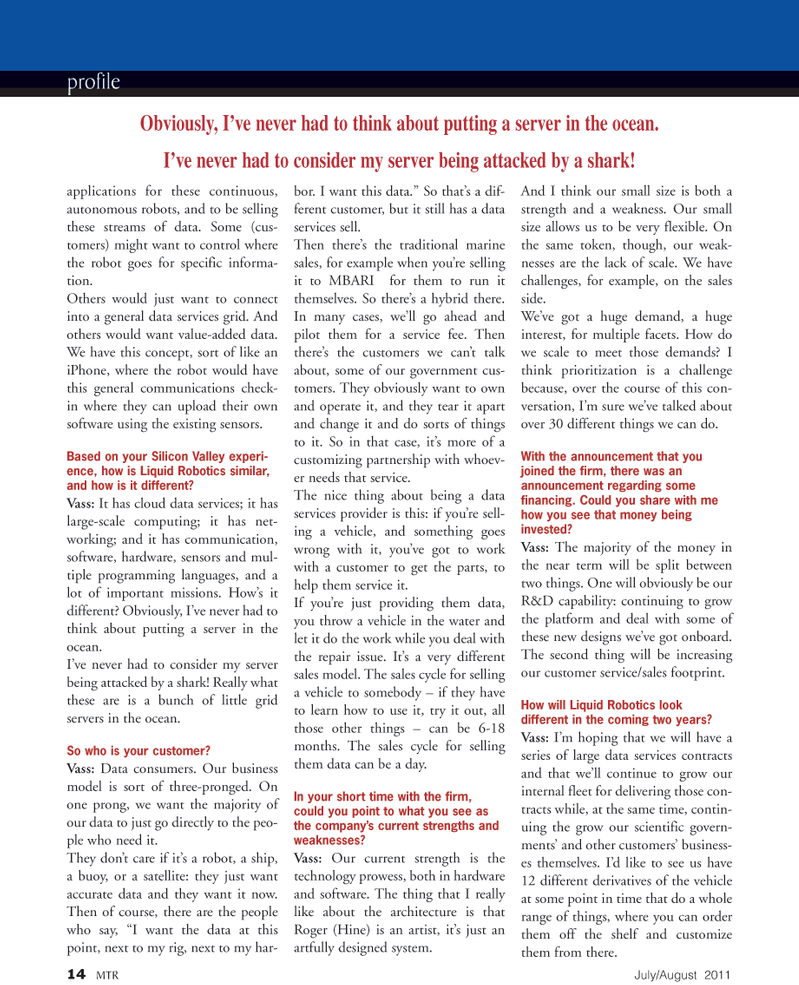
Page 14: of Marine Technology Magazine (July 2011)
MTR100 Edition
Read this page in Pdf, Flash or Html5 edition of July 2011 Marine Technology Magazine
14MTRJuly/August 2011 profile applications for these continuous,autonomous robots, and to be selling these streams of data. Some (cus- tomers) might want to control where the robot goes for specific informa- tion. Others would just want to connect into a general data services grid. And others would want value-added data. We have this concept, sort of like an iPhone, where the robot would have this general communications check-in where they can upload their own software using the existing sensors. Based on your Silicon Valley experi- ence, how is Liquid Robotics similar, and how is it different? Vass: It has cloud data services; it has large-scale computing; it has net-working; and it has communication, software, hardware, sensors and mul- tiple programming languages, and a lot of important missions. Hows it different? Obviously, Ive never had to think about putting a server in the ocean. Ive never had to consider my server being attacked by a shark! Really what these are is a bunch of little grid servers in the ocean. So who is your customer?Vass: Data consumers. Our business model is sort of three-pronged. On one prong, we want the majority of our data to just go directly to the peo- ple who need it. They dont care if its a robot, a ship, a buoy, or a satellite: they just want accurate data and they want it now. Then of course, there are the people who say, I want the data at this point, next to my rig, next to my har-bor. I want this data.? So thats a dif- ferent customer, but it still has a data services sell. Then theres the traditional marine sales, for example when youre selling it to MBARI for them to run it themselves. So theres a hybrid there. In many cases, well go ahead and pilot them for a service fee. Then theres the customers we cant talk about, some of our government cus- tomers. They obviously want to own and operate it, and they tear it apart and change it and do sorts of things to it. So in that case, its more of a customizing partnership with whoev- er needs that service. The nice thing about being a dataservices provider is this: if youre sell- ing a vehicle, and something goes wrong with it, youve got to work with a customer to get the parts, to help them service it. If youre just providing them data, you throw a vehicle in the water and let it do the work while you deal with the repair issue. Its a very different sales model. The sales cycle for selling a vehicle to somebody ? if they have to learn how to use it, try it out, all those other things ? can be 6-18months. The sales cycle for selling them data can be a day. In your short time with the firm, could you point to what you see asthe companys current strengths and weaknesses?Vass: Our current strength is the technology prowess, both in hardware and software. The thing that I really like about the architecture is that Roger (Hine) is an artist, its just an artfully designed system. And I think our small size is both a strength and a weakness. Our small size allows us to be very flexible. On the same token, though, our weak- nesses are the lack of scale. We have challenges, for example, on the salesside. Weve got a huge demand, a huge interest, for multiple facets. How do we scale to meet those demands? I think prioritization is a challengebecause, over the course of this con- versation, Im sure weve talked about over 30 different things we can do. With the announcement that you joined the firm, there was an announcement regarding some financing. Could you share with me how you see that money beinginvested? Vass: The majority of the money inthe near term will be split between two things. One will obviously be our R&D capability: continuing to grow the platform and deal with some ofthese new designs weve got onboard. The second thing will be increasing our customer service/sales footprint. How will Liquid Robotics look different in the coming two years? Vass: Im hoping that we will have a series of large data services contracts and that well continue to grow our internal fleet for delivering those con- tracts while, at the same time, contin-uing the grow our scientific govern- ments and other customers business- es themselves. Id like to see us have 12 different derivatives of the vehicle at some point in time that do a wholerange of things, where you can order them off the shelf and customize them from there. Obviously, Ive never had to think about putting a server in the ocean. Ive never had to consider my server being attacked by a shark!

 13
13

 15
15
